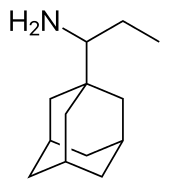Adapromine
Adapromine is an antiviral drug of the adamantane group related to amantadine (1-aminoadamantane), rimantadine (1-(1-aminoethyl)adamantane), and memantine (1-amino-3,5-dimethyladamantane) that is marketed in Russia for the treatment and prevention of influenza.[1][2][3][4] It is an alkyl analogue of rimantadine and is similar to rimantadine in its antiviral activity but possesses a broader spectrum of action, being effective against influenza viruses of both type A and B.[1][2][5] Strains of type A influenza virus with resistance to adapromine and rimantadine and the related drug deitiforine were encountered in Mongolia and the Soviet Union in the 1980s.[6][7]
 | |
| Clinical data | |
|---|---|
| Other names | JP-62, MK-3 |
| Routes of administration | Oral |
| Legal status | |
| Legal status |
|
| Identifiers | |
| |
| CAS Number | |
| PubChem CID | |
| ChemSpider | |
| CompTox Dashboard (EPA) | |
| Chemical and physical data | |
| Formula | C13H23N |
| Molar mass | 193.334 g·mol−1 |
| 3D model (JSmol) | |
| |
Electroencephalography (EEG) studies of animals suggest that adapromine and related adamantanes including amantadine, bromantane (1-amino-2-bromophenyladamantane), and memantine have psychostimulant-like and possibly antidepressant-like effects, and that these effects may be mediated via catecholaminergic processes.[8][9][10][11] These psychostimulant effects differ qualitatively from those of conventional psychostimulants like amphetamine however, and the adamantane derivatives have been described contrarily as "adaptogens" and as "actoprotectors".[12]
In 2004, it was discovered that amantadine and memantine bind to and act as agonists of the σ1 receptor (Ki = 7.44 μM and 2.60 μM, respectively) and that activation of the σ1 receptor is involved in the dopaminergic effects of amantadine at therapeutically relevant concentrations.[13] These findings might also extend to the other adamantanes such as adapromine, rimantadine, and bromantane and could explain the psychostimulant-like effects of this family of compounds.[13]
See also
References
- Spasov, A. A.; Khamidova, T. V.; Bugaeva, L. I.; Morozov, I. S. (2000). "Adamantane derivatives: Pharmacological and toxicological properties (review)". Pharmaceutical Chemistry Journal. 34 (1): 1–7. doi:10.1007/BF02524549. ISSN 0091-150X.
- Lavrova, L. N.; Indulen, M. K.; Ryazantseva, G. M.; Korytnyi, V. S.; Yashunskii, V. G. (1990). "Synthesis and biological activity of some 1-hydroxy-3-aminoalkyladamantanes and their derivatives". Pharmaceutical Chemistry Journal. 24 (1): 35–39. doi:10.1007/BF00769383. ISSN 0091-150X.
- Gavrilova, N. A.; Frolenko, T. A.; Semichenko, E. S.; Suboch, G. A. (2010). "Synthesis of naphtho[1,2-d]imidazoles containing an adamantyl fragment". Russian Journal of Organic Chemistry. 46 (5): 777–778. doi:10.1134/S1070428010050349. ISSN 1070-4280.
- Rodionov, V. N.; Sklyarova, A. S.; Shamota, T. V.; Schreiner, P. R.; Fokin, A. A. (2011). "Selective reductive dimerization of homocubane series oximes". Russian Journal of Organic Chemistry. 47 (11): 1695–1702. doi:10.1134/S1070428011110078. ISSN 1070-4280.
- Leneva, I. A.; Glushkov, R. G.; Gus’kova, T. A. (2004). "Drugs for chemotherapy and prophylaxis of influenza: Mechanisms, efficacy, and safety (a review)". Pharmaceutical Chemistry Journal. 38 (11): 590–596. doi:10.1007/s11094-005-0036-9. ISSN 0091-150X.
- Kozeletskaia KN, Grinbaum EB, Zhamsrangiĭn M, Burmistrova VV, Kiselev OI (1990). "[The isolation and study of the properties of current influenza A viruses (H1N1) with a natural resistance to remantadine]". Vopr. Virusol. (in Russian). 35 (4): 289–93. PMID 1701588.
- Kozeletskaia KN, Karginov VA, Kiseleva OI, Mishin VP, Grinbaum EB, Burmistrova VV (1995). "[The origin of resistance to chemicals of naturally occurring isolates of influenza A virus]". Vestn. Akad. Med. Nauk SSSR (in Russian) (9): 36–41. PMID 7580412.
- Krapivin SV, Sergeeva SA, Morozov IS (1992). "[A spectral analysis of the effect of adapromine on brain bioelectrical activity]". Eksp Klin Farmakol (in Russian). 55 (3): 6–8. PMID 1458170.
- Krapivin, S. V.; Sergeeva, S. A.; Morozov, I. S. (1998). "Comparative analysis of the effects of adapromine, midantane, and bromantane on bioelectrical activity of rat brain". Bulletin of Experimental Biology and Medicine. 125 (2): 151–155. doi:10.1007/BF02496845. ISSN 0007-4888.
- Krapivin SV, Voronina TA (1995). "[Comparative quantitative pharmacological-EEG analysis of the effects of psychostimulants]". Vestn. Akad. Med. Nauk SSSR (in Russian) (6): 7–16. PMID 7627000.
- Krapivin, S. V.; Sergeeva, S. A.; Morozov, I. S.; Dulpe, I. U. (1991). "Spectral analysis of the effect of midantane on bioelectrical activity of the rat brain". Bulletin of Experimental Biology and Medicine. 112 (1): 975–978. doi:10.1007/BF00841147. ISSN 0007-4888.
- Morozov, I. S.; Ivanova, I. A.; Lukicheva, T. A. (2001). "Actoprotector and Adaptogen Properties of Adamantane Derivatives (A Review)". Pharmaceutical Chemistry Journal. 35 (5): 235–238. doi:10.1023/A:1011905302667. ISSN 0091-150X.
- Peeters, Magali; Romieu, Pascal; Maurice, Tangui; Su, Tsung-Ping; Maloteaux, Jean-Marie; Hermans, Emmanuel (2004). "Involvement of the sigma1 receptor in the modulation of dopaminergic transmission by amantadine". European Journal of Neuroscience. 19 (8): 2212–2220. doi:10.1111/j.0953-816X.2004.03297.x. ISSN 0953-816X. PMID 15090047.